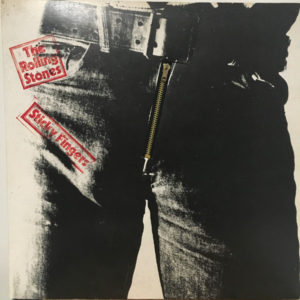Rolling Stones 59100
Producer: Jimmy Miller
Track listing: Brown Sugar / Sway / Wild Horses / Can’t You Hear Me Knocking / You Gotta Move / Bitch / I Got the Blues / Sister Morphine / Dead Flowers / Moonlight Mile

May 22, 1971
4 weeks
The world had changed dramatically since the Rolling Stones scored their first Number One album in the United States with Out of Our Heads, and so too had the Stones. On July 3, 1969, the body of founding member Brian Jones was found at the bottom of his swimming pool, less than a month after he’d left the band. On December 6, 1969, as Mick Jagger was onstage singing “Sympathy for the Devil,” violence first broke out at a free concert at Altamont Raceway in Northern California. A young fan was later stabbed to death by Hell’s Angels working as security guards, while the band played “Under My Thumb.” Yet despite this adversity, or maybe even because of it, the Stones were reaching new creative heights in their recorded work.
Sticky Fingers marked the debut of Rolling Stones Records, the band’s own label, distributed through Atlantic’s Atco imprint. It was also guitarist Mick Taylor’s first full studio album as a member of the Stones — Taylor, formerly of John Mayall’s Bluesbreakers, had played on only part of 1969’s Let It Bleed.
“Mick [Jagger] was very up,” recalls Andy Johns, one of the engineers who worked on the sessions. “Mick Taylor was very much a part of the proceedings and the vibes weren’t that heavy. It was just a good time and quite a creative period for them.”
Adding to the good vibes was the fact that a portion of the album was recorded at Jagger’s Stargroves estate. “The Rolling Stones had just finished building a mobile unit, which was the first proper audio truck in Europe,” says Andy Johns. “It was a lot more fun than being in a studio. We were all living together and we used different rooms for different sounds. There was a very communal sort of vibe.”
One of the first songs cut during the sessions at Stargroves was “Bitch.” Says Johns, “The horn players, Jim Price and Bobby Keys, were recorded from the cloak room, because it had a really good sound.”
Sticky Fingers marked a departure for the Stones. Aside from the rockers “Brown Sugar” and “Bitch,” which opened on each side, the album was the band’s most low-key and introspective effort to date. The album-closing ballad “Moonlight Mile” reflected the mood. “That was recorded live except for the strings and the vocals,” says Johns. “We got that done at about 5:30 a.m. and the sun was just coming in the windows. It’s got that early-in-the-morning feel to it, where everyone has been up all night having a good time after a nice dinner and then got down to work. I don’t think we would have gotten that feel if we had been at Olympic.”
The band did return to Olympic Studios in London to record “Can’t You Hear Me Knocking” and several other cuts. Tracks such as “Brown Sugar” and “Wild Horses” were cut at the legendary Muscle Shoals Sound in Alabama during the band’s 1969 American tour.
The former track stirred controversy. Some critics complained Jagger’s lyrics were racist and sexist, and also be interpreted as a reference to heroin. Nonetheless, on May 29, 1971, “Brown Sugar” became the Stones sixth One single on the American charts.
“Brown Sugar” wasn’t the only controversial aspect of Sticky Fingers. The cover, designed by Andy Warhol, featured a close-up shot of a male model from the waist to the knees, in a pair of tight jeans, complete with a working zipper, and a pair of bulging briefs on the inner sleeve.
Fittingly, Sticky Fingers zipped up the charts in a mere two weeks. After debuting at number 10 on May 15, the album nailed down the top spot a week later.
THE TOP FIVE
Week of May 22, 1971
1. Sticky Fingers, The Rolling Stones
2. Jesus Christ Superstar, various artists
3. 4 Way Street, Crosby, Stills, Nash & Young
4. Up to Date, Partridge Family
5. Mud Slide Slim and the Blue Horizon, James Taylor
